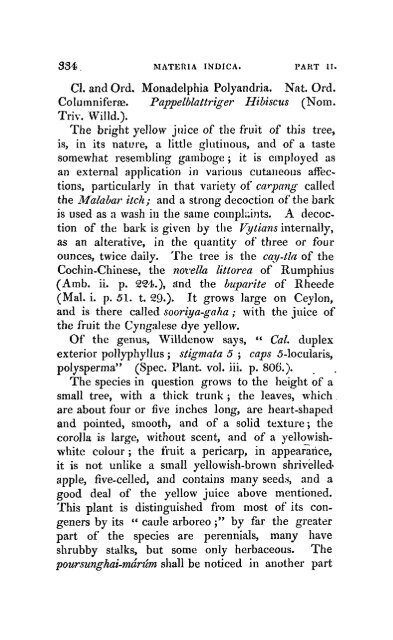You also want an ePaper? Increase the reach of your titles
YUMPU automatically turns print PDFs into web optimized ePapers that Google loves.
334. l\Ii\TETIIA <strong>INDICA</strong>. PART II.<br />
Cl. and Ord. Monadelphia Polyandria. Nat.Ord.<br />
Columniferre. Pappelblattriger Hibiscus (Nom.<br />
Triv. -Willd.).<br />
The bright yellow juice of the fruit of this tree,<br />
is, in its natllre, a little glutinous, and of a taste<br />
somewhat resembling gamboge; it is employed as<br />
an external application in various cutaneous affections,<br />
particularly in that variety of carpang called<br />
the M alahar itch; and a strong decoction of the bark<br />
is used as a wash in the same comph;.ints. A decoction<br />
of the bark is given by the Vytians internal1y,<br />
as an alterative, in the quantity of three or four<br />
ounces, twice daily. The tree is the caJ/-tta of the<br />
Cochin-Chinese, the nO'cella littorea of Rumphius<br />
(Amb. ii. p. QQ?l.), and the buparite of Rheede<br />
(Mal. i. p. 51. t. Q9.). It grows large on Ceylon,<br />
and is there called sooriya-gaha; with the juice of<br />
the fruit the Cyngalese dye yellow.<br />
Of the genus, Willdenow says, " Cal. duplex<br />
exterior pollyphyllus; stigmata 5; caps 5-locularis,<br />
polysperma" (Spec. Plant. vol. iii. p. 806.). _<br />
The species in question grows to the height of a<br />
small tree, with a thick trunk; the leaves, which.<br />
are about four or five inches long, are heart-shaped<br />
and pointed, smooth, and of a solid texture; the<br />
corolla is large, without scent, and of a yellowishwhite<br />
colour; the fruit a pericarp, in appearance,<br />
it is not unlike a small yellowish-brown shrivelledapple,<br />
five-celled, and contains many seed . .;, and a<br />
good deaJ of the yellow juice above mentioned.<br />
This plant is distinguished from most of its congeners<br />
by its "caule arboreo;" by far the greater<br />
part of the species are perennials, many have<br />
shrubby stalks, but some only herbaceous. The<br />
poursunghai.marum shall be noticed in another part

















